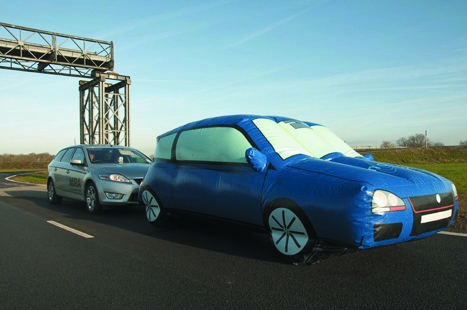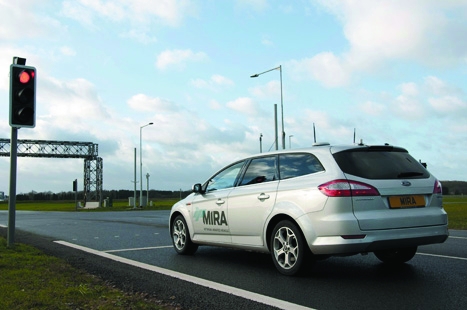A semi-automated test vehicle is helping engineers fast-track intelligent transport systems
Robotic cars are no longer the future. The basic technology that enables vehicles to drive themselves and, crucially, avoid other road users has pretty much been cracked, not just by car manufacturers but by technology companies ranging from BAE Systems to Google. Getting these vehicles onto the road, however, is another matter – both in terms of developing certifiable and affordable systems and convincing the public that they are completely safe.

While some believe we could see fully autonomous cars on the market within a few years, it seems most likely that the technologies will be introduced gradually.
In fact, we’ve already seen the precursors of robot cars emerge in the likes of Ford’s latest Focus with its warning sensors and emergency automatic braking and a number of models with adaptive cruise control that adjusts the car’s speed to maintain the distance from the car in front. One of the challenges in bringing these kind of systems to market is finding a way to reliably prove their functionality and their safety. The answer that the Motor Industry Research Association (MIRA), a vehicle test specialist, has come up with is a network-assisted vehicle (NAV): a car whose brake and accelerator can be pre-programmed to follow a specific route or operated remotely via a wireless network.
’A lot of what people do at MIRA already is repeated drive cycles, looking at fuel economy, how wear and tear occurs over a period of time,’ said Tim Edwards, senior engineer at MIRA and lead on the NAV project. ’So we can programme the car to always go round the track in the same way, so it always accelerates and always brakes. That requirement already exists but is going to become increasingly interesting to people who are developing new sensors for the car, a new radar system or a new laser system or camera system, or it could be something else [such as] a GPS technology. So you want to put something new into the car and know how it performs in a controlled test.’
Built around a Ford Mondeo featuring adaptive cruise control, the speed of the NAV is controlled remotely by a centralised control system that determines the appropriate speed of the car in real time or with pre-programmed routes selected via a tablet computer in the car.
We’ve already seen the precursors of robot cars emerge in the likes of its automatic breaking
But it still requires a human driver to steer the vehicle. Why didn’t the MIRA team go a step further and make it fully autonomous? The answer is partly cost and partly practicality.
’We’re very conscious of future test requirements as complexity builds,’ said Edwards. ’There are fully autonomous vehicles available today to solve your test problems if you spend half a million pounds or £1m. But then next year’s problem comes along and you need three of those cars and it’s another £3m.
’Fully autonomous vehicles tend to be completely independent of what everyone else is doing. We want cars that are working together in unison effectively.’

It’s this idea of multiple vehicles working together that gives the NAV its edge. It’s not just a way to trial individual systems; it also helps to create a controlled but real-world scenario as part of MIRA’s innovITS urban test track. This replicates the kind of wireless, 3G and GPS signals available in city environments – complete withsignal failures.
’Cars are becoming increasingly intelligent, increasingly aware of what’s immediately in front of and behind them,’ Edwards told The Engineer. ’In the future, that’s going to extend to quite high-resolution information about everything around that car, potentially up to a couple of miles away using wireless connections and things like that.
’So the challenge of doing automotive tests to a very high safety standard becomes much more difficult because we can’t just take a component in isolation and put it through its lifecycle. These things need to be put into a realistic environment for them to behave in their normal manner.’
That means if you’re testing a car with autonomous capabilities such as a collision-warning system, you need to be able to precisely control the other vehicles it is detecting and interacting with. This can also extend to testing ’platooning’, where two or more cars synchronise their movements, leading to more efficient traffic flow.
’To test that, there are no official test standards yet, but you could imaginethe complexity of a two-vehicle scenario just escalates as you get multiple vehicles,’ said Edwards.
Starting with an existing intelligent system (adaptive cruise control) gave the MIRA team a headstart in developing the technology for the NAV.
“Cars are becoming increasingly intelligent, increasingly aware of what’s in front of them”TIM EDWARDS, MIRA
But, alongside developing the software to operate the car and monitor its feedback, there were still two key technical challenges – the first of which was ensuring the car’s safety once elements of control were given to an off-board processing unit. ’We needed to make sure anything we put in was failsafe and that the driver was always aware of what was going on and had a mechanism to bring control back,’ Edwards told The Engineer.
The other was working out how to override the automatic systems and take control of the vehicle.
’To actually get in and use that existing system involves an element of reverse engineering,’ said Edwards. ’Effectively, we’ve developed something new, a bespoke technology, which is capable of interacting with the CANbus [controller-area network bus: the manufacturer’s system that allows devices to communicate without a central host computer].’
MIRA is now working with potential customers on developing specific test cycles for technologies. But the way the industry is evolving means that it’s not just car manufacturers that are interestedin the NAV’s capabilities. Future cars won’t just talk to each other; they’ll talk to traffic control centres, databases of roadworks and even traffic lights.
’The automotive industry is no longer self contained,’ said Edwards. ’As vehicles become more aware of what the traffic lights are doing and the traffic lights are already aware of what the vehicle’s doing, we don’t want the two systems to be second-guessing each other. You want the two things to work together. So we are actually working with some of the infrastructure suppliers now to work out what that strategy might be in future.’
Greater vehicle communication could even affect driver behaviour by guiding people away from potential traffic build-ups or encouraging them to drive in a more fuel-efficient manner. And improving the quality of real-time data could give people greater faith in smart infrastructure and autonomous systems, leading to a higher take-up of the technology. It’s incremental steps such as this that will bring robotic cars out of the test centres and onto the roads.
in depth
test driving
The NAV is more than just a host for trialling vehicle systemsThe network-assisted vehicle (NAV) isn’t just a host vehicle for testing systems; it’s a platform for developing applications. One of the first MIRA has been experimenting with is platooning, where two or more cars synchronise their movements.
’This is a way of taking speed control of the car and making it more intelligent,’ said Tim Edwards of MIRA. ’So it’s understanding the traffic flow from 200m to maybe two miles in front of you and changing your speed in advance of when you need it so you get there at the right time.’
Another possible application is to create intelligent intersections where drivers are warned of oncoming vehicles before they reach the junction. This application could be especially useful for fast-travelling vehicles such as motorbikes.
MIRA software developer Mandeep Panesar said: ’An emergency vehicle [such as] an ambulance could send its position to an intersection to say it’s going to go through this set of lights and the traffic light system adapts and makes sure it’s green by the time the emergency vehicle goes past, preventing situations where it has to go through a red light, which could potentially be very unsafe.’




April 1886: the Brunkebergs tunnel
First ever example of a ground source heat pump?